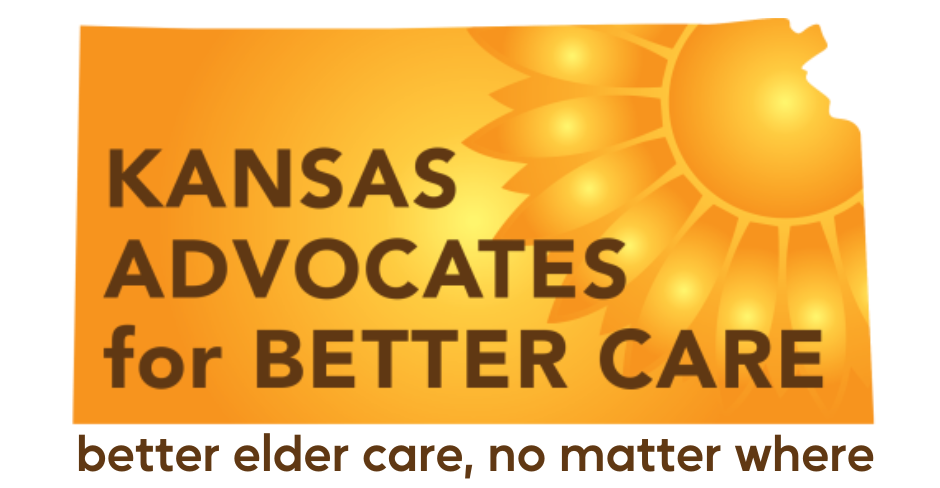Advocacy in Action (July 2024): Problem Facilities
Libby Hastings • July 5, 2024

The Long-Term Care Community Coalition (LTCCC) recently released alarming data on the state of nursing facilities across the United States, revealing that nearly one in four nursing homes (24.6%) qualify as "problem facilities." This term encompasses nursing homes that have received a one-star rating on the federal Five-Star Quality Rating System, are part of the Special Focus Facility (SFF) Program or are SFF candidates. These facilities are notable for their substandard care and persistent compliance issues.
National and Kansas-Specific Findings
The data paints a concerning picture of nursing facility care quality nationwide, and Kansas is notably worse than the national average. According to LTCCC's data, out of the 306 nursing facilities in Kansas, 25.2% are classified as "problem facilities", 59.8% of nursing facilities in Kansas are for-profit, and 75% of "problem facilities" in Kansas are for-profit.
The Five-Star Quality Rating System
The Centers for Medicare & Medicaid Services (CMS) utilizes the Five-Star Quality Rating System to aid consumers in comparing nursing homes. This system rates facilities on a scale from one to five stars, with five-star ratings indicating superior care and one-star ratings flagging the poorest quality. The effectiveness and accuracy of the CMS Five-Star Quality Rating System has been debated among long-term care advocates, residents, and their families. A star rating is composed of three parts: outcomes from the state inspection report, staffing, and quality measures.
For-Profit Facilities and Quality Concerns
The LTCCC report highlights a troubling correlation between for-profit status and lower-quality care. A federal government study, released in November 2023, concluded that for-profit nursing facilities tend to have lower quality ratings, fewer registered nurses, and more safety violations, prompting one to wonder if for-profit facilities prioritize financial returns over patient care. A February 2021 study from the National Bureau of Economic Research found that going to a facility owned by a private equity firm increased the chance that a resident would die by 10%, compared with living in another type of facility.
The Special Focus Facility Program
The SFF Program targets nursing facilities with a history of serious quality issues. Facilities are identified based on their performance over the last three standard health survey cycles and three years of complaint surveys. Points are assigned for deficiencies cited during inspections, with higher points given for more severe violations. Those facilities with the highest points become SFF candidates, marking them as requiring significant improvement. The methodology behind the SFF Program is the same as that used for health inspections within the Five-Star Quality Rating System. This rigorous approach ensures that only those facilities with the most concerning track records are selected for intensified oversight.
Implications for Consumers
The LTCCC's findings and data serve as a crucial reminder for consumers to be vigilant when selecting nursing facilities. The prevalence of "problem facilities", especially among for-profit institutions, underscores the importance of thorough research and consideration of a facility's rating and compliance history.
As always, if you would like Consumer Information Reports about any licensed long-term care facility in Kansas, feel free to call or email. There is never a charge for any of our materials.
At KABC, we will continue to advocate for increased staffing, quality care, and financial transparency within for-profit nursing facilities.

Opinion piece from Dave Ranney, current KABC Board Member and retired newspaper reporter: In a recent Kansas News Service story on Sen. Roger Marshall’s appearance at a town hall meeting in Oakley, Kansas, (pop. 1,982), a board member with the local nursing home said he’d hoped to hear about issues “…affecting nursing homes right now. Rural hospitals are hurting but all people wanted to do was scream at the senator.” The board member’s concerns are valid and deeply troubling. Cuts in Medicaid spending will be devastating. Medicaid is the backbone of long-term care in Kansas; 57 percent of the state’s nursing home residents rely on Medicaid for their care. These are frail elders whose estates have been depleted. They have no money. Medicaid reimbursement rates are, at best, break-even. They’re not ‘profit centers.’ Even a small reduction in rates will push many rural facilities to the brink of closure. Quality of care, too, is sure to suffer. Medicare, unfortunately, does not cover nursing home care. Rural families will be left with no choice but to move their loved ones far from home to receive the care they need and deserve. Already, eight of the state’s 105 counites are without a nursing home; at least 40 have only one. National surveys have found that a fourth of the nursing homes in Kansas are providing sub-standard care, usually due to inadequate staffing. Recruiting and retaining nurses and healthcare staff in small towns is critical. The board member would do well to consider what’ll happen when DOGE figures out that Medicaid is paying for care that often falls short of federal standard. Lawmakers on both the state and national levels have a responsibility to ensure stable Medicaid funding to keep existing facilities open while, at the same time, investing in community-based services that offer lower-cost, in-home care options that allow people to remain in their communities. Sincerely, Dave Ranney Dave Ranney is a retired newspaper reporter, he lives in Lawrence, Kansas.





